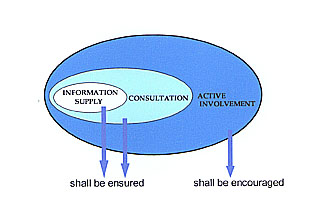 |
|
Requirements of Article 14 WFD (Public information and consultation) Reference: Guidance on Public Participation in relation to the Water Framework Directive, December 2002 |
There are many reasons to start a public participation process. The key benefits include:
• better-informed and more creative decision making;
• increased public acceptance, less litigation, fewer delays and more effective implementation;
• more open and integrated governance and more transparency in the planning process;
• a broader knowledge base through the use of stakeholder’s knowledge and experience;
• promotion of social learning through a constructive dialogue in which all relevant parties involved - the various publics, governments and experts - learn from each other.
The WFD, therefore, brings new and innovative concepts to sustainable water management in Europe. Although some provisions concerning public participation are contained in Annex VII A. 9 and 11, the starting point for the consideration of participation is found in Article 14 of the WFD which provides that:
• Member States shall encourage active involvement of all interested parties in the implementation of the Directive, not only regarding the development of a river basin management plan, but from the very beginning of the implementation of the WFD (transformation into national laws, characterization and analysis of water bodies, establishment of monitoring programmes, development of the programmes of measures).
• Member States shall ensure a three-phased public consultation process on the RBMP by
- allowing the public to participate in the drafting of the timetable and work program (due by December 2006), in the identification of significant water management issues in the river basin (due by December 2007) and in the drafting of the river basin management plan (due by December 2008);
- allowing a six-months´ period for comments in each phase;
- changing the relevant documents taking into account the received comments.
 |
Throughout the process, the public should be provided access to background documents and information. Although Article 14 of WFD is rather extensive, its provisions raise many questions with regard to its implementation. In order to provide specific guidelines on the implementation of this Article, the "Guidance on Public Participation in Relation to the WFD” was developed under the Common Implementation Strategy for WFD. The Guidance is a horizontal document, which means that it is also of relevance for other guidance documents, designed to guide and steer the implementation of the WFD. However,, the Guidance for Public Participation can not be seen as a "blueprint” because political, organizational and cultural conditions differ between river basin countries. Therefore, the main aims of the Guidance for Public Participation are
• to create a common understanding regarding public participation;
• to illustrate the usefulness of public participation from the beginning of the implementation of the WFD on. Public participation must be seen as a benefit rather than a hindrance;
• to analyse the provisions of Article 14 WFD in detail
• to provide advice on how these provisions can be implemented in practical terms;
• to highlight the need to evaluate the participation process together with the participants in order to improve the quality of public participation;
• to identify key success factors regarding effective public participation (such as political commitment, capacity building, mutual respect, flexibility, valuing diversity of knowledge).
It is obvious that public participation has to be organized in the river basin districts. In international river basins a lot of coordination is necessary to harmonize the activities with regard to public involvement on the different levels, i.e. international, national, regional and local. The ICPDR was the first international river basin organization to discuss a public participation strategy. The process started with a successful workshop held in Bratislava in April 2003. The Guidance Document was carefully examined with regard to its implementation in the Danube River Basin. The results of the workshop were used to establish a draft strategy for organising public involvement. The strategy is currently being discussed.
Heide Jekel, heide.jekel@bmu.bund.de
Key questions and answers provided by the Guidance Document:
What is public participation?
Allowing the public to influence the outcome of plans and working processes.
Who should participate?
The broad public as well as stakeholders, based on a detailed stakeholder analysis.
What is access to background information?
The WFD requires access to background information, which means sufficient information
supply in the different implementation steps (via brochures, websites, etc.).
What is consultation?
The lowest level of public participation, which is based on information supply.
Consultations include the providing of documents for comments, the organization
of public hearings, etc..
What is active involvement?
A higher level of participation, which implies that stakeholders are invited to
contribute actively to the planning process by discussing issues and proposing
solutions.
More information:
www.forum.europa.eu.int/Public/irc/env/Home/main